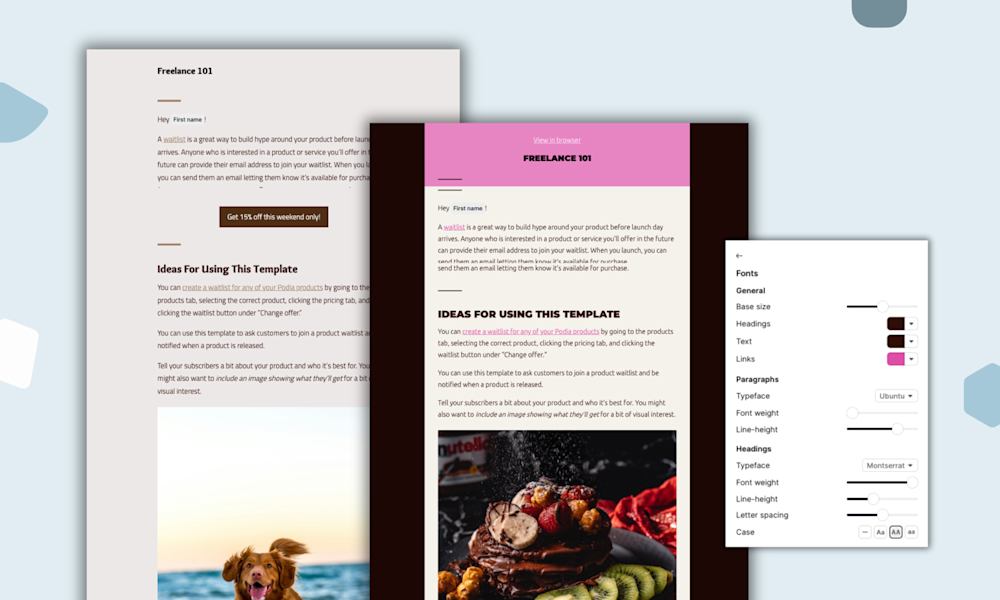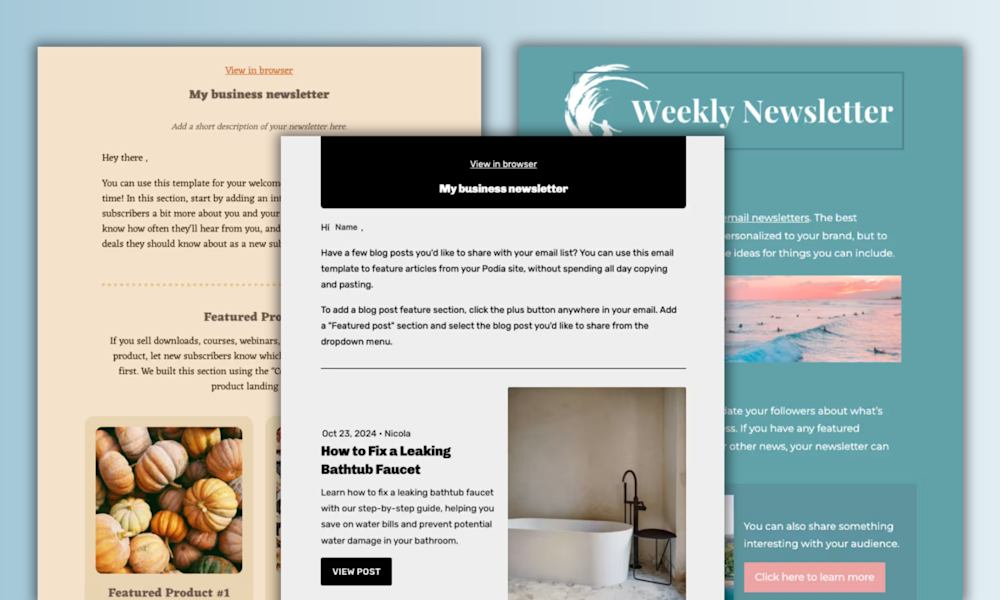If you’re looking for an email marketing tool, chances are you’ve come across Mailchimp. Mailchimp is one of the most well-known and widely-used email service providers on the market, and they’ve been a big name in the industry since they set up shop back in 2001.
Today, Mailchimp is still a solid email marketing platform, and it probably wouldn’t get recommended so often if that weren’t the case.
But it’s not without criticism, so it’s worth taking a look at what former Mailchimp customers loved about the platform, and why they ultimately left.
At Podia, we periodically run surveys to make sure we’re building the best features for our customers. Around the time we launched Podia Email, we asked people to tell us about their experiences with other email tools.
One hundred and twelve people said they had used Mailchimp, and they shared some of the things they liked and disliked about it.
No platform will be perfect for everyone, Podia included, so we’re sharing the findings of these surveys to help you choose the best tool for you and your business.
Your email marketing is important. Your email list is important. When you set up these essential parts of your business with the right platform, you can avoid lots of legwork (and expensive, duct-taped-together software hacks) down the road.
In this guide, we’ll cover:
-
What Mailchimp does well, according to previous customers
-
What Mailchimp does NOT do well, according to previous customers
-
Why people switch from Mailchimp to Podia Email
Let’s find out what real customers had to say about Mailchimp.
See why creators are switching from Mailchimp to Podia Email. Try Podia and you'll get unlimited email sends with a platform that's simple to use and already connected to everything else. It's free for your first 100 subscribers, and you can set up automations and scheduled emails from day one. Sign up for Podia.
What does Mailchimp do well, according to customers?
Mailchimp is a popular email marketing software option for a good reason. Plenty of users are happy with the tool and have used it for a long time, and Mailchimp’s free plan makes it a good starting point for many creators.
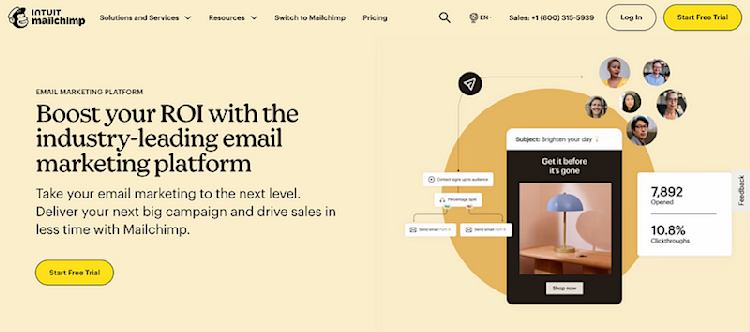
First, here’s a high-level look at Mailchimp’s features:
-
Pricing: Mailchimp’s pricing is based on subscriber count and features. Select how many contacts you need and pick the plan that has the features you want. Prices go up as you add contacts or advance to higher-level plans.
-
Audience: Within your account, you can have different audiences, segmentation, contact profiles, and tags to manage your subscribers.
-
Design: Mailchimp comes with email templates and an email design studio. You can remove the Mailchimp branding on paid plans.
-
Marketing: Sending emails is Mailchimp’s bread and butter, but they also have email scheduling, landing pages, pop-up forms, and a social media posting feature.
-
Automation: Build single-step or multi-step automations. You can also make advanced automations with multiple starting points and branching points, as well as in-depth customer journeys.
-
Insights and reporting: Mailchimp has A/B testing, multivariate testing, and a subject line tool. Higher-tier plans also include features like send-time optimization and delivery by time zone.
-
Website: Mailchimp also includes a website with unlimited pages and a free Mailchimp domain. You can connect a custom domain on the $10/month website plan, purchased separately from email plans.
-
E-Commerce: Mailchimp doesn’t let you sell products directly, but you can integrate with +300 tools to get this functionality.
-
Support: Free users get email support for 30 days, and paid plans have email and live chat support. The highest-tier Premium plan also comes with phone support.
These features stood out most with the +100 previous Mailchimp users we talked to:
Mailchimp has a free plan
Of those surveyed, 10% said their favorite thing about using Mailchimp was the free plan.
Mailchimp’s free version lets you have up to 500 subscribers and send 1,000 emails per month with a maximum send limit of 500 emails in a day. The free plan also includes a landing page and website, and you get email support for the first 30 days.
When you’re first starting your online business, a free plan removes initial barriers to entry and makes the platform more accessible.
Though Mailchimp did face criticism for recent changes to its free plan (the number of free subscribers dropped from 1,000 to 500), it’s still a good option if you’re building your business on a tighter budget.
Email templates and customizations
Another thing former customers like about Mailchimp is the customizable email templates. Based on the survey, 14% of previous users liked how you can customize your colors, fonts, text sizes, and other formatting options within your emails. There’s also a large library of templates to choose from if you need a place to start.
One respondent said that they loved “the easy and elegant design templates” and another said that there were “lots of flexible template options integrated right into the email creator.”
Because Mailchimp is a no-code email builder, you don’t need to know HTML or CSS to make your emails look nice.
Analytics and customer data
Also on the list of positives were Mailchimp’s analytics tools and customer tracking features. All plans have basic reporting, tags, segmentation, and a subject line helper. Higher-tier plans come with A/B testing and other content optimization tools.
As sewing instructor and previous Mailchimp user Monika Potaszynska puts it, “[Mailchimp’s] analytics were very detailed. I could segment my audience more quickly with pre-set options such as ‘opened/didn’t open last five campaigns.’”

Bottom line: Mailchimp gets good marks for the following:
-
There’s a free plan
-
You can use customizable email templates
-
There are analytics and customer tracking
That said, when asked what they liked about using Mailchimp, 14% of respondents said they didn’t like anything. Let’s dig into what people weren’t a fan of.
What does Mailchimp NOT do well, according to past customers?
No platform is perfect for everyone, even a platform as well-known as Mailchimp. In general, the previous users we heard from weren’t too keen on the cost, complexity, and limited free plan.
Mailchimp pricing gets expensive quickly
One big downside of Mailchimp according to past users? The price.
Just over 30% of survey respondents said their least favorite part was the expensive price tag and that they didn’t like how Mailchimp’s prices had gone up in recent years.
Mailchimp offers four different plans with increasingly advanced features, and they all go up in price as you add on more subscribers. The only exception is the free plan, which tops out at 500 subscribers and has limited features. We’ll cover that more in-depth later.
This means there are potentially hundreds of pricing combinations available, and it can be confusing to figure out what you need. Plus, a feature you want might be gated on a higher tier plan, meaning you’ll have to upgrade everything to use it.
Here’s how Mailchimp’s pricing plans work for the first few subscriber tiers.
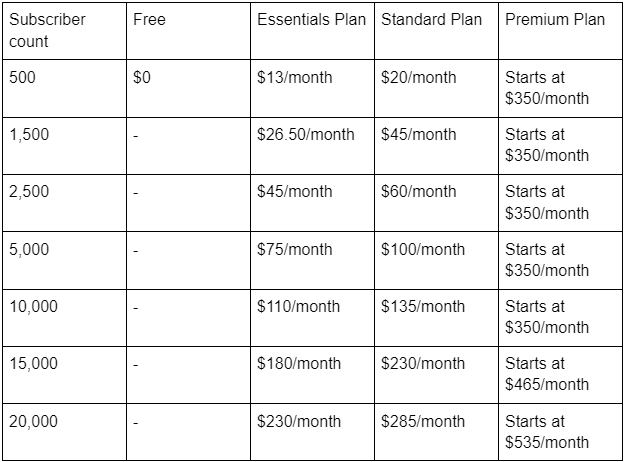
As your list grows, your monthly price could also grow significantly, especially if you want more advanced features.
Another thing ex-users didn’t love about Mailchimp’s pricing was the overage fees. Mailchimp has email send limits, which means there’s a set number of messages you can send to your followers every month. This is true of all plans, even the top-tier ones.
For instance, you can only send 1,000 emails per month on the free plan. On the top-tier Premium plan, you can only send 15x the total number of subscribers you have (so you can send 15,000 total emails if your list has 1,000 subscribers).
Mailchimp will charge overages if you go over this amount, which can lead to an unpleasant surprise bill. This can be a big limitation for creators and small business owners because you may want to write an extra newsletter one month, run a flash sale, or simply send out a spontaneous update.
Instead of doing it when inspiration strikes, you’ll need to calculate if you have enough sends left for the month.
Some users found Mailchimp to be complicated
The previous Mailchimp users we surveyed are split on whether or not they found Mailchimp easy or difficult to use.
While 21% of respondents said that Mailchimp was easy to use, 33% said that it was complicated to figure out. People seemed pretty divided on this topic — some said it was a breeze and others said they could hardly get an email set up without headaches.
One user felt like the interface was “all over the place”, and another user pointed out that building emails in Mailchimp slowed down their computer so severely it was difficult to get anything done.
Limited free option
Mailchimp’s free plan gives you up to 500 subscribers, but the downside is that you’re limited to sending just 1,000 emails per month.
You also don’t get access to essential features like email scheduling or automation tools on the free plan, so you’ll have to keep track of all your messages manually.
On top of that, free Mailchimp users only get customer support for the first 30 days after signing up, which means you’re on your own if issues arise later.
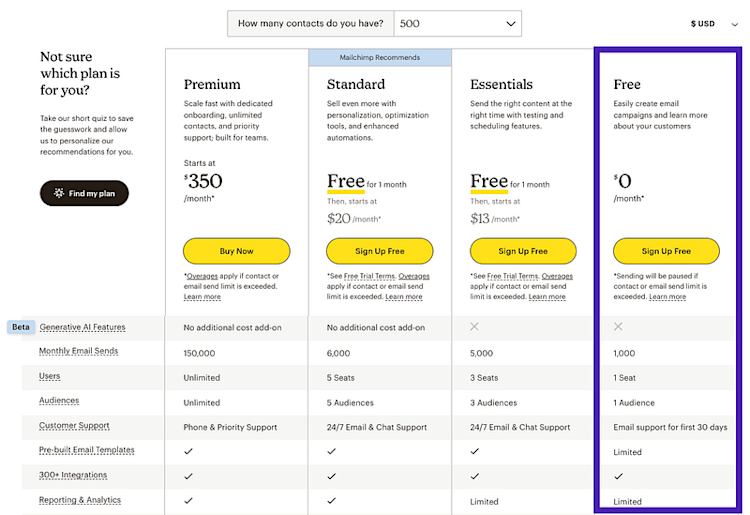
At the end of the day, being able to use any tool for free is great, so you can’t knock the free plan too hard. But with many companies offering a free option and comparable feature set, you might find a better platform that suits your needs.
Which brings us to our next section:
Why are people switching from Mailchimp to Podia Email?
The main reasons people are leaving Mailchimp in favor of Podia Email are the cost, ease of use, and feature-rich plans. People also love having the option to run their entire business under one roof.
Podia is less expensive than Mailchimp
For 16% of respondents, Podia’s price tag was the number one reason they switched away from Mailchimp. Across nearly all pricing tiers, Podia Email is less expensive than Mailchimp.
In general, Podia’s pricing is simpler since all email features are available on all plans. You only upgrade as your list grows, and when that time comes, Podia’s prices are some of the lowest in the industry.
Here’s how the pricing for Podia and Mailchimp compare:
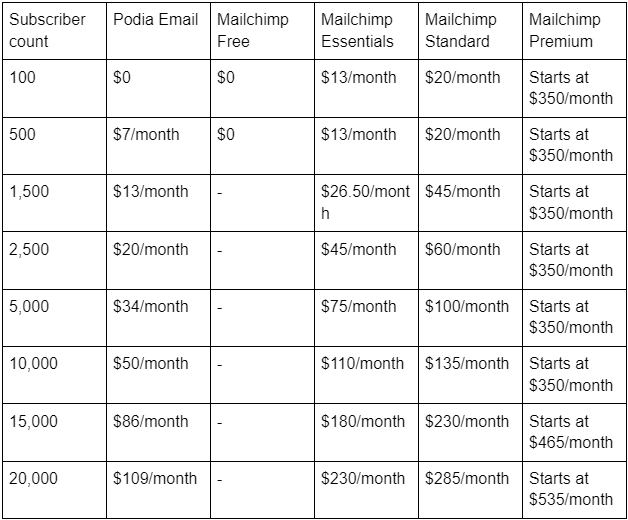
In many cases, even Mailchimp’s lowest-tier plan is significantly more expensive than Podia. As your list grows, Mailchimp could be over twice as pricey for the same number of subscribers.
And unlike Mailchimp, all Podia Email plans come with full features and unlimited email sends.
Mailchimp is less expensive if you have 100–500 subscribers, but after that point, Podia Email could easily save you hundreds or thousands of dollars each year.
Podia has a simple and intuitive email interface
Hey, price isn’t everything.
Previous Mailchimp users also like how Podia is simple to use so you can quickly make whatever type of email you want. Podia Email has a library of templates to help you start building fast, and you can also use your previous emails as a starting point, so you don’t have to work from scratch.
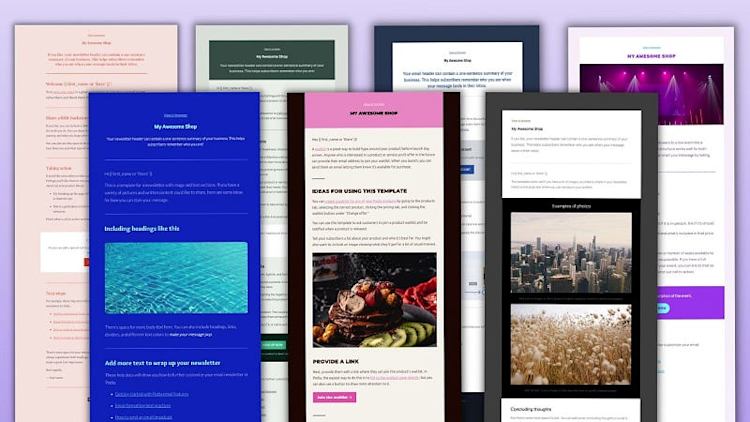
If you do want to start from scratch, you can add sections and make style changes in the email builder with just a few clicks.
Podia’s simple email editor interface and ease of use were the primary reasons for switching for 20% of survey respondents.
As Podia creator Susanne Rudd puts it,
“Mailchimp is quite complicated as the help guides are full of links to other parts (if you want to know x you need to know y first). I find I start with one issue and end up with lots more! It’s not at all straightforward to use. I love how clear and straightforward Podia is.”
And Liz Reitzig from Nourishing Liberty said,
“It (Mailchimp) was SUPER hard to use and too complicated and that made it difficult for me to learn. I’ve been using Podia email now for a few months and just not retaining (thankfully) habits from past platforms.”
If you’d like to see how easy Podia Email is, you can try it for yourself for free. Get started with your free 30-day trial of Podia and click the “Email” tab to start building emails and campaigns.
Podia has advanced email features (and more!)
Mailchimp may give users a higher number of subscribers, but Podia has more features.
With Podia, you get a website, landing pages, and the ability to sell digital downloads and coaching products. You also get full email features (including marketing automations, scheduling, campaigns, unlimited email sends, and all email templates) for up to 100 subscribers.
Mailchimp gates automations, advanced segmentation, and email scheduling on higher-tiered plans.
With Podia, you only pay more as your list grows, so someone with 20 subscribers has the same advanced features as someone with 20,000. List size doesn’t have to determine your marketing strategy, which is why Podia gives you all the tools of a premium platform from day one.
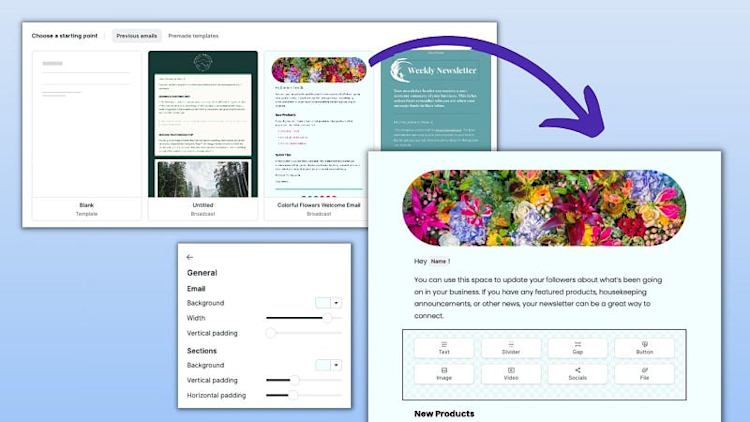
Plus, you can start making sales by offering digital downloads or coaching products, and you can even set up a lead magnet to drive traffic to your email list.
Mailchimp’s free users only get 30 days of email support. After that, you’re on your own and you’ll need to upgrade to a paid plan to access chat and email support in the future. That said, there are help docs available to all users at any time.
Podia users get expert email and chat customer support, help docs, free training courses, guides, video tutorials, and access to our welcoming Podia Community.
Podia is an all-in-one platform for running your online business
Perhaps the most important reason people switch from Mailchimp to Podia is that Mailchimp focuses mainly on email and Podia is an all-in-one platform for running your entire online business.
Podia Email is automatically connected to your products, website, courses, customers, affiliates, and any other data inside your Podia account. You don’t need to set up any integrations or mess with code to make your tools talk to each other — everything is ready to go from the minute you sign in.
It’s no wonder 61% of survey respondents mentioned having everything in one place as their reason for switching.
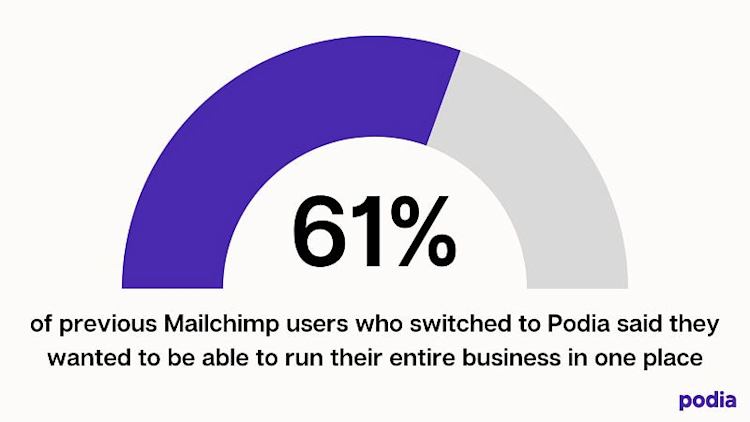
As compassionate time management coach Anne Boccato puts it,
“I had to begin using a paid service to create evergreen campaigns, and Podia came out with the revamped email tool right as I began looking for an affordable email service that did what I needed. It’s extra convenient to have it link to my courses, students, and products.”
Mom entrepreneur coach Ami Youngs said they switched because,
“I wanted everything in one place, and Podia email was easier to use even without all the functions that Mailchimp was capable of.”
And sewing instructor Monika Potaszynska mentioned that,
“It made sending emails to my customers easier. I want to start a membership, so having everything in one place was very important to me.”
And holistic aromatherapist Erin Oberlander said,
“I wanted a one-stop shop for everything in my business.”
Because everything is all in one place with Podia, it’s also easy to see your analytics and email data right in your dashboard, including how much income you’ve made off a particular email.
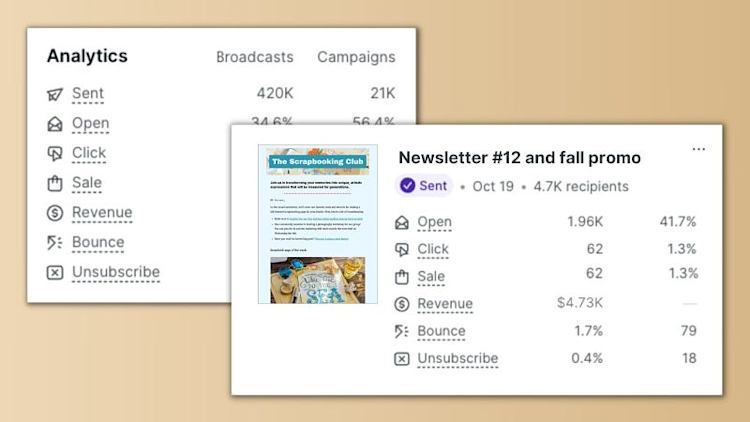
In just a few clicks, you can also send messages to specific subsets of your audience, like people who have signed up for your lead magnet but have not bought your paid course, people who haven’t clicked an email recently, or customers of a particular product.
Plus, an all-in-one platform means that your email is connected to your website builder and landing pages, all of which you can customize any way you want.
Build a beautiful website and set up as many landing pages for products and email capture forms as you need. You can use unlimited signup forms to funnel new members into different tags, so you always send the right message to the right people.

Podia’s email builder is user-friendly for beginners and experienced creators alike. You don’t need to learn a complicated third-party platform to get your business (and your products, and your email) up and running.
Simply put, if you want to run your business in one place with your email automatically connected to your products, website, and customers, Podia could be a good fit for you too.
Mailchimp Review: Is Mailchimp right for you?
Mailchimp works well as an email marketing tool and has lots of features. Mailchimp stands out because it has a free plan with a 500-subscriber limit and users generally like the easy-to-use templates and analytics.
Mailchimp also has automations, campaigns, and advanced optimization features available on higher-priced plans.
Podia Email, on the other hand, shines because it is already connected to your customers, courses, website, coaching, affiliate marketing, and other products, so you can have the simplicity of running everything in one place.
Podia’s pricing is lower than Mailchimp’s in most cases. No one wants to spend hours connecting dozens of tools and complicated tech, so we made Podia simple and easy, with everything you need out of the box.
If you’re still on the fence about which platform is right for you, we’d love for you to give Podia a try. It’s free for 30 days, and the free Podia Email plan comes with all email marketing features and room for 100 subscribers, so take it for a spin today.
It might just be the right Mailchimp alternative for you too.
Email Marketing FAQs
What is Mailchimp?
Mailchimp is a popular email marketing tool for businesses, individuals, startups, and creators. You can use Mailchimp to stay in touch with followers and subscribers through email, and some plans include digital marketing tools, advanced segmentation, and helpful automations.
What are some Mailchimp alternatives?
Unsurprisingly, our favorite Mailchimp alternative is Podia Email! You can also read about other email marketing tools similar to Mailchimp in these guides.
What are the disadvantages of Mailchimp?
The disadvantages of Mailchimp are the cost, complexity, and limited free plan. Mailchimp’s pricing and plans have changed recently, and people seemed split on whether or not they found Mailchimp very easy or very difficult to use. Plus, there are email send limits on all plans so you could be faced with overage charges if you send too many emails.
Is it good to use Mailchimp?
Mailchimp is a good choice if you’re looking for a basic email service tool with a free plan for up to 500 subscribers. They have a lot of users who like the service, but if it’s not for you, you can consider an alternative like Podia Email for lower prices.
Is Mailchimp actually free?
Yep! Mailchimp has a free plan that you can use if your contact list is under 500 subscribers. It includes 1,000 monthly email sends, tags, and basic segmentation. Keep in mind that if you go over the monthly email send limit, there may be overage charges, and you’ll need to pay extra for features like automations and email scheduling.
What is the best email marketing service?
We’re a little biased here, but we think Podia Email is the best email marketing service around. With Podia Email, you get a beautiful email builder, templates, and unlimited email sends on all plans. You can also make email marketing campaigns and see how much money you earn from each email. Podia Email is automatically connected to your website, landing pages, products, courses, customers, and everything else.
